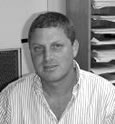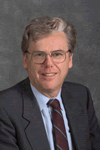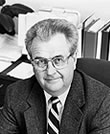 |
‘Blind’ Cells See Light;
Maybe Humans Are Next
By
Robert Sanders
|
|
|
|
 |
 |
|
|
Kramer |
|
|
|
Scientists
at the University of California, Berkeley, and Berkeley
Lab have given "blind" nerve cells the ability
to detect light, paving the way for an innovative therapy
that could restore sight to those who have lost it through
disease. A team lead by neurobiologist Richard
H. Kramer, UC Berkeley professor of molecular
and cell biology and a materials scientist at the Lab,
and Dirk Trauner, assistant professor of chemistry,
inserted a light-activated switch into brain cells normally
insensitive to light, enabling the researchers to turn
the cells on with green light and turn them off with
ultraviolet light. The work was supported by a grant
from Fight-for-Sight and an award from Berkeley Lab.
Full
story.

Attwood
Edits ‘Roadmap’
For EUV Light Sources
|
|
|
|
 |
 |
|
|
Attwood |
|
|
|
A
special cluster of papers that provide a timely review
of the status of high power Extreme Ultraviolet (EUV)
plasma sources for semiconductor manufacturing has been
published in the Journal of Physics D: Applied Physics
(J. Phys. D). Guest Editor David Attwood
of Berkeley Lab’s Center for X-ray Optics writes
in his editorial, “The International Technology
Roadmap for Semiconductors provides industry expectations
for high-volume computer chip fabrication a decade into
the future …The leading candidate for the 2009
node is EUV lithography.” All eight articles will
be freely available online
until the end of February 2005 and to institutional
subscribers following this date.
 |
|
|
|
|
|
|
|
 |
 |
|
|
Park |
|
|
|
Novel
Quasicrystals
Present Less Friction Quasicrystals,
solid materials possessing an odd five-fold or ten-fold
symmetry (making the ten-fold solid partly periodic
and partly aperiodic) and which form dodecahedral grains,
seem to present less friction than do many other materials.
For the past ten years no explanation for this has been
found. Berkeley Lab postdoctoral fellow J.Y.
Park and his colleagues here and at Ames Lab
have looked at this issue by dragging a probe microscope
across a sample. At a recent AVS Science & Technology
meeting in Anaheim, Park reported finding was a highly
anisotropic friction for his Al-Ni-Co quasicrystal:
low friction when sliding the probe in the aperiodic
direction and high friction when sliding along the periodic
direction. Read the paper here.

|
|
|
|
 |
 |
|
|
Cerny |
|
|
|
Panel
Studies Nuclear
Science Workforce Issues
The
joint Department of Energy/National Science Foundation
Nuclear Science Advisory Committee (NSAC) devoted its
November meeting to the nuclear science and engineering
workforce, and how best to educate, prepare, diversify
and maintain it for the 21st century. Berkeley Lab’s
Joseph Cerny was among those evaluating
DOE and NSF investments in education relevant to nuclear
science. A survey of current graduate students showed
"substantial satisfaction" with a career in
nuclear science, Cerny said, but also revealed "a
significant fraction" of highly dissatisfied individuals.
Full story.

|
|

